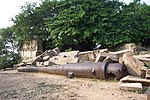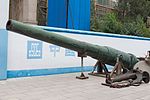24 cm K L/35
| 24 cm K L/35 | |
|---|---|
 The forward 24 cm K L/35 gun turrets aboard SMS Odin | |
| Type | Naval Gun Coastal Artillery Railway Artillery |
| Place of origin | German Empire |
| Service history | |
| In service | 1890-1945 |
| Used by | German Empire Argentina Austria-Hungary |
| Wars | Boxer Rebellion World War I World War II |
| Production history | |
| Designer | Krupp |
| Designed | 1888 |
| Manufacturer | Krupp |
| Produced | 1888 |
| Specifications | |
| Mass | 21.5 t (23.7 short tons) |
| Length | 8.4 m (27 ft 7 in) |
| Barrel length | 7.8 m (25 ft 7 in) |
| Shell | Separate loading bagged charges and projectiles |
| Shell weight | 140–215 kg (309–474 lb) |
| Caliber | 24 cm (9.4 in) 35 caliber |
| Breech | Cylindro-prismatic breech block |
| Elevation | -4° to +25° |
| Traverse | -150° to +150° |
| Rate of fire | 2 rpm |
| Muzzle velocity | 580–650 m/s (1,900–2,100 ft/s) |
| Maximum firing range | 13 km (8.1 mi) at +25°[1] |
The 24 cm K L/35 was a German Naval Gun developed in the years before World War I that armed ships of the Imperial German Navy, Argentine Navy and the Austro-Hungarian Navy. Guns removed from ships of the Imperial German Navy were modified to perform Coastal Artillery and Railway Artillery roles and saw service in both world wars. The actual bore diameter was 23.8 cm (9.4 in), but the classification system for artillery rounded up to the next highest centimeter.
History[]
In 1888 Krupp designed the 24 cm K L/35 and started production to arm two classes of the Imperial German Navy's coastal defense ships. Krupp also produced guns for export that armed one class of coastal defense ships for Argentina and one class of protected cruisers and one unique armored cruiser for Austria-Hungary. The Ottoman Osmaniye-class ironclads were rearmed with these guns in the early 1890s.[2]
[]
The 24 cm K L/35 was the primary armament of the Siegfried-class and Odin-class coastal defense ships of the Imperial German Navy.[3]
- German ship details:
- Siegfried-class - The six ships of this class had a primary armament of three guns in an unusual arrangement. Two MPL C/88 single gun turrets were mounted side-by-side forward, while a third was mounted aft of the central superstructure in a single gun turret.[4]
- Odin-class - The two ships of this class had a primary armament of three guns in an unusual arrangement. Two MPL C/93 single gun turrets were mounted side-by-side forward, while a third was mounted aft of the central superstructure in a single gun turret.[5]
The 24 cm K L/35 was also the primary armament of the Argentine Navy's Independencia-class coastal defense ships.
- Argentine ship details:
- Independencia-class – The two ships of this class had a primary armament of two guns, which were mounted in two single gun turrets, one fore and one aft of the central superstructure.[6]
The 24 cm K L/35 was the primary armament of the Kaiser Franz Joseph I-class of protected cruisers and the unique armored cruiser SMS Kaiserin und Königin Maria Theresia.
- Austro-Hungarian ship details:
- Kaiser Franz Joseph I-class - The two ships of this class had a primary armament of two guns, which were mounted in two single gun turrets, one fore and one aft of the central superstructure.[7]
- SMS Kaiserin und Königin Maria Theresia - This ship had a primary armament of two guns, which were mounted in two single gun turrets, one fore and one aft of the central superstructure.[8]
Coastal Artillery[]
During 1916 the Odin-class ships were decommissioned and disarmed. The 24 cm K L/35 guns salvaged from these ships were converted to coastal artillery. Three guns were emplaced at Battery Bremen on Norderney and three guns were emplaced at Battery S1 on Sylt.[9] They remained there until the late 1930s.[citation needed]
There are currently four guns belonging to battery No4 at Puerto Belgrano, Argentina.[10]
Ottoman Empire purchased thirty 24 cm K L/35 guns during the 1880s and a number of these engaged the allied naval forces during the Gallipoli campaign.[10]
Railway Artillery[]
Beginning in 1937 the six guns at Norderny and Sylt were converted to railway artillery and were collectively known as 24 cm Theodor Bruno Kanone (E). During the Battle of France Theodor Brunos equipped three batteries of two guns each. Later one battery of four guns defended Cherbourg from 1941 until June 1944 when they were destroyed during the Battle of Cherbourg.[11]
Photo Gallery[]

A 24 cm L/35 fortress gun in Dongguan China.

One of the four 24 cm L/35 guns of battery No4 at Puerto Belgrano.

A 24 cm L/35 fortress gun in the Military Museum in Beijing China.

One of the Ottoman guns which helped sink the French battleship Bouvet.

A 24 cm railroad gun captured by the Russians during the Petsamo–Kirkenes Offensive.
Bibliography[]
- Friedman, Norman (2011). Naval Weapons of World War One. Barnsley, South Yorkshire, UK: Seaforth. ISBN 978-1-84832-100-7.
- Chamberlain, Peter (1979). Weapons of the Third Reich: An Encyclopedic Survey of All Small Arms, Artillery and Special Weapons of the German Land Forces 1939-1945. New York: Doubleday. ISBN 0-385-15090-3.
- François, Guy (2006-01-01). Eisenbahnartillerie: Histoire de l'artillerie lourd sur voie ferrée allemande des origines à 1945. Paris: Editions Histoire et Fortifications. ISBN 2915767084.
References[]
- ^ DiGiulian, Tony. "Germany 24 cm/35 (9.4") SK L/35 - NavWeaps". www.navweaps.com. Retrieved 2017-03-23.
- ^ Langensiepen, Bernd (1995). The Ottoman steam navy, 1828-1923. Güleryüz, Ahmet., Cooper, James. London: Conway Maritime Press. p. 133. ISBN 0851776108. OCLC 32707576.
- ^ Friedman, Norman (2011-01-01). Naval weapons of World War One. Seaforth. ISBN 9781848321007. OCLC 786178793.
- ^ "SIEGFRIED coast defence battleships (1890-1894) - Kaiserliche Marine (Germany)". www.navypedia.org. Retrieved 2017-03-23.
- ^ "ODIN coast defence battleships (1896) - Kaiserliche Marine (Germany)". www.navypedia.org. Retrieved 2017-03-23.
- ^ "Nueve de Julio coast defence battleships (1891-1892) - Argentinean Navy (Argentina)". www.navypedia.org. Retrieved 2017-03-23.
- ^ "KAISER FRANZ JOSEPH I protected cruisers (1890-1892) - K-u-K Marine (Austro-Hungarian Navy) (Austria-Hungary)". www.navypedia.org. Retrieved 2017-03-23.
- ^ "KAISERIN UND KÖNIGIN MARIA THERESIA armoured cruiser (1894) - K-u-K Marine (Austro-Hungarian Navy) (Austria-Hungary)". www.navypedia.org. Retrieved 2017-03-23.
- ^ Chamberlain, Peter (1979). Weapons of the Third Reich : an encyclopedic survey of all small arms, artillery, and special weapons of the German land forces, 1939-1945. Doubleday. ISBN 0385150903.
- ^ Jump up to: a b Smith, Stephen (2017). Heavyweights The Military Use of Massive Weapons. Chartwell Books. p. 106. ISBN 9780785835493. OCLC 975485233.
- ^ Francois, Guy (2006-01-01). Eisenbahnartillerie : histoire de l'artillerie lourde sur voie ferrée allemande des origines à 1945. Éd. Histoire et fortifications. ISBN 2915767084. OCLC 470748404.
External links[]
- http://www.navweaps.com/Weapons/WNGER_945-35_skc88.php
- http://www.navypedia.org/ships/germany/ger_bb_siegfried.htm
- http://www.navypedia.org/ships/germany/ger_bb_odin.htm
- http://www.navypedia.org/ships/argentina/arg_bb_nueve_de_julio.htm
- http://www.navypedia.org/ships/austrohungary/ah_cr_kaiser_franz_joseph_i.htm
- http://www.navypedia.org/ships/austrohungary/ah_cr_kuk_maria_theresia.htm
- http://navalhistory.flixco.info/H/229314x54503/8330/a0.htm
- Naval guns of Germany
- Naval guns of Austria-Hungary
- World War I naval weapons
- 240 mm artillery




